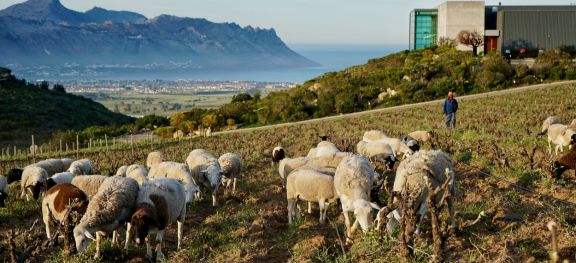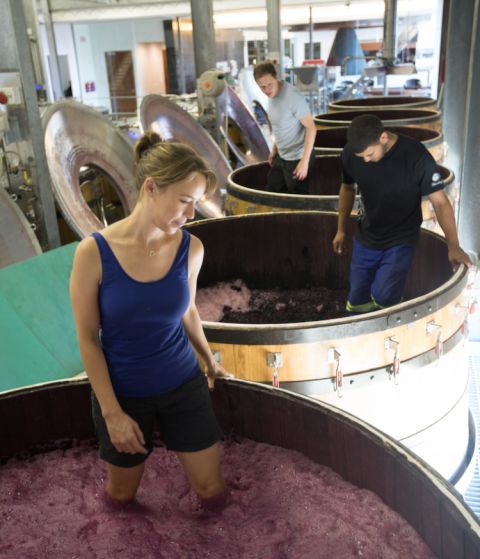Waterkloof, Boreas 2020 Stellenbosch

A serious, refined and ageworthy Cabernet Franc-based South African red that is excellent value, from as little as £28.48 and $80.
The name Waterkloof, meaning ‘water ravine’ in Afrikaans, is a name that might be familiar to visitors to JancisRobinson.com. This South African wine producer, established just over twenty years ago by Englishman Paul Boutinot, son of restaurateurs, founder and owner from the early 1980s until its sale in 2013 of the eponymous UK wine merchant, and erstwhile owner of Clos de Cray in Montlouis in the Loire, has over the years provided us with many wines of the week.
I first met Boutinot at the estate in 2009 when the winery on the Schapenberg (Afrikaans for ‘sheep mountain’) was still under construction. Even so, I remember a comprehensive tasting and delicious lunch on the building site.
Waterkloof was, and is, Boutinot's holy grail, the place he chose to invest in after a 10-year search for somewhere he could produce 'truly fine wine with a defining sense of origin’. The estate sits at 300 m (984 ft) of elevation, with magnificent views, just a few kilometres from the False Bay coast in the centre of the Hottentots-Holland and Helderberg Mountains. The vineyards, first planted in the early 1970s, had been replanted in the mid 1990s so are now really coming into their own, all certified organic and incorporating biodynamic practices. No longer surrounded by alien tree species such as oak and pine, the land is now home to hundreds of indigenous flower species, restoring biodiversity to the estate, almost half of which is set aside for conservation purposes. (For more on the estate’s Biodiversity Champion status, and how it has been achieved, see the Waterkloof website.)
This strategic location, one of the coolest sites in the Stellenbosch region, explains why it was, according to the Waterkloof website, the lookout post for Willem Adriaan van der Stel, Cape Colony Governor 1699–1707, allowing him to identify visiting ships and ‘race into town and sell his produce before the competition could’. It was also where he grazed his sheep. Sheep are back, as shown in the photo above, but now they are used to keep down the cover crops in the vine rows and fertilise the soil.
Paul Boutinot is retired in name only. According to his son Louis, Waterkloof’s export manager, Paul travels regularly to Waterkloof and is ‘still very involved in the production side, although cellarmaster Nadia Langenegger (in action below) is very much in charge of winemaking’. Paul joined in my email exchange with Louis to point out that prior to 2020 almost all of their wines – with the exception of Circle of Life – were made from a single variety because they found that trying to improve these varietal wines by adding a percentage of another made them unbalanced. This was especially so when they tried to add their most successful bordeaux variety, Cabernet Franc, to the reds.
Not so in 2020, the first year in which they made not one but two reds under their top Waterkloof label, previously used only for their best whites: Sauvignon Blanc from 2005 and Chenin Blanc in 2021. Alongside the 2020 Waterkloof Syrah came Waterkloof, Boreas 2020 Stellenbosch, named after the fiercest wind god in recognition of the character-forming cooling winds from False Bay. (The technical sheet for this wine describes the wind speed as ‘hectic’.) The face of Boreas is also the winery logo.
Boreas 2020 is a blend of 51% Cabernet Franc grown on decomposed granite, 25% Merlot, 14% Petit Verdot and 10% Cabernet Sauvignon, all grown on compacted sandstone. The vineyards are dry-farmed at an elevation of 240–250 m, some south- and some north-facing. The grapes are hand-picked and hand-sorted and fermented with ambient yeasts in an old open-topped French oak foudre. With the exception of the Cabernet Sauvignon, the grapes are fermented as whole bunches, then foot-trodden, or punched down manually, and finally aged for 27 months in French oak barriques (10% new) and one 9,000-litre old French oak foudre. The only addition is sulphur dioxide.
I can absolutely see why this lovely wine, which is delicious now and capable of long ageing, is worthy of Waterkloof's top label, made only in the very best years. I gave the wine a score of 17 and thought it would continue to improve in bottle for another 10 years, probably longer. The alcohol is 14%. Here is my tasting note:
Marked by the herbaceousness of the Cabernet Franc and the stemmy herbal freshness from the whole bunches. But not in the least unripe just very aromatic. Intense dark-red fruits that dominate both the nose and the palate with an unexpected youthfulness. However, the tannins are rounded and silky-smooth while being firm enough to shape all that pure, leafy fruit. Elegant and scented on the palate, with a long finish showing excellent freshness and refinement. A lovely wine, perfect now but should age well. The oak is well integrated, helping to round out the texture, though it does still show in a chocolate-like sweetness on the finish. Fortunately the freshness is sufficient to outrun the oak impression. A clever, well-made wine that should appeal widely unless you really don't like the herbaceous side of the Cabernets.
Boreas is imported into the UK by Boutinot Wines and is well distributed around the country.
The US importer is TruVino. Boreas is widely available in the state of Georgia (thanks to a successful visit there by Louis Boutinot!) and online from Perrine’s Wine Shop and Central Wine Merchants. Email Kristin Luu at TruVino for availability elsewhere in the US.
It is also available in South Africa.
All images, apart from mine of the winery under construction, courtesy of Waterkloof.
Find many more reviews of Waterkloof wines in our 250,000-strong tasting notes database.
Become a member to view this article and thousands more!
- 15,427 featured articles
- 275,714 wine reviews
- Maps from The World Atlas of Wine, 8th edition (RRP £50)
- The Oxford Companion to Wine, 5th edition (RRP £50)
- Members’ forum
- 15,427 featured articles
- 275,714 wine reviews
- Maps from The World Atlas of Wine, 8th edition (RRP £50)
- The Oxford Companion to Wine, 5th edition (RRP £50)
- Members’ forum
- 48-hour preview of all scheduled articles
- Commercial use of our wine reviews






